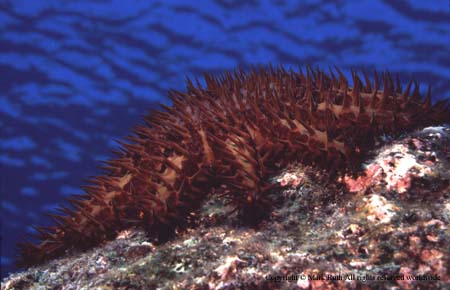Effects of Water
Crown-of-Thorns, Acanthaster planci, Kona Hawaii, Pacific Ocean

Visit my underwater
photo gallery to see many more great shots.
There are many differences you will encounter underwater that you do not notice when taking pictures above water.
Movement is the first thing you will notice. When you are in the water you move back and forth as the water moves. It is important to go with the flow and learn to time your pictures with the movement. If you try to fight the water you will just get tired.
as you go deeper in the water you will also be under more and more pressure. Although your body may not feel the pressure your camera, housing, and strobes do. You must be sure the camera you are using is designed for the depth you are going.
Another thing you will notice with depth is that the light will be affected. There will be less light the deeper you go. That is what most people expect, but you may also notice that things do not seem as colorful. Water absorbs color in the order of the rainbow. First you will loose red then orange and yellow until the main colors are green or blue. You will only be able to see red for the first 10 to 20 feet then it does not look red anymore. In fact it when you are very deep it will look black. This is where the strobe comes in. You could still take a picture without it but that red sponge would be black. Even with the strobe you must be only a few feet away to get all the red back in the photo.
The amount of light that goes into the water depends on the angle of the sunlight on the top of the water. The brightest time would be when the sun is directly overhead. The water will reflect some of the light just like a mirror when it is early or late in the day. If you are planning on using natural light to take your picture you may want to do it at high noon.
Try to get close to the subject you are trying to photograph. Thing under water seem to be 25% bigger than they really are. When you get your pictures back that big fish may not look as big as you remember.
One last thing about water. Stuff floats in the water. If you stir up the bottom you can create a big cloud of "dust" in the water. This is not good for pictures! When you take a picture in water with a lot of stuff floating in it you will discover a problem called BACKSCATTER. This is one of your worst enemies since many a great shot will be destroyed by backscatter. The problem is the strobe. When you use a flash in dirty water you get some of the light reflecting back off of the particles in the water and causing white spots in your pictures. You can reduce this affect if you can move the strobe off to the side away from the camera. The further the strobes are from the camera lens the less reflected light gets back to the lens. This is the reason for the arms that you attach the strobes on. Many photographers will have the strobes over 3 feet away from the camera.
|
|
Home Page |
Next |

